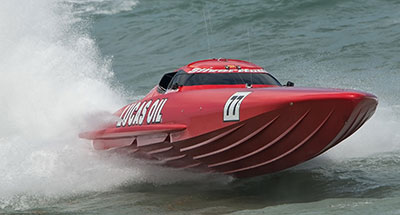
IoT Provides Competitive Edge in Speedboat Racing
Do you think of IoT as mostly collecting consumer data? This case study is a great example of IoT technology being used to gain a literal competitive advantage.
- By Fern Halper
- July 22, 2016
While doing research for TDWI's upcoming IoT Readiness Assessment, I had the pleasure of speaking with Nigel Hook, cofounder and president of SilverHook powerboats, about his company's use of IoT. This case study is a great example of how IoT is being used to literally gain a competitive advantage.
Offshore high-speed boat racing has been an organized sport for more than 100 years. The race typically consists of 10 to 20 boats on a 4- to 5-mile track. It is a fast-paced sport where every second matters. Recently, SilverHook began to incorporate IoT analytics into its racing boats for two reasons. The first is to gain a competitive advantage. IoT can provide real-time analytics to help drivers make decisions about where to turn or alert them if there is a problem with an onboard system. The second reason is to engage fans by letting them see what is happening in the boats in real time using a virtual cockpit.

Hook says he uses sensor data, along with environmental data, to provide analytics about onboard systems and to improve performance. Why? "We want to push these very expensive, very high-horsepower exotic engines to their limit without destroying them. We want to optimize their life span, which is impossible for a human to do."
To accomplish this, SilverHook collects data on board its boats, which it sends to the cloud for analysis (using IBM's IoT Foundation for streaming the data). Analytics, such as rules or models, developed in the cloud are pushed down to a Cisco gateway device on the boat where data is processed during the race. For instance, water is used to cool the engines, so if the water pressure starts to change, an alert is generated.
The Data Capture Plan
Hook says that a data capture plan is key. "We are collecting all kinds of data -- temperature, pressure, vibrations, and so on. We spent a lot of time thinking about the data and the fact that this data is coming from different sources that have different frequencies. We need a common time stamp. Describing the data is key."
According to Hook, it is also important to have a fast prototyping platform to be able to experiment and try out new ideas. SilverHook does this using IBM's Bluemix platform-as-a-service (PaaS) in the cloud. Hook says, "PaaS allows you to iterate as fast as you can."
Because the races occur 150 miles offshore, SilverHook is also providing a virtual cockpit view of their boats to the fans on shore. Fans can see how fast the boat is going and view the other gauges on the boats via the virtual cockpit. Hook believes this will increase fan engagement.
Next on the company's road map is text to voice -- so that drivers can hear alerts. They are also looking at analyzing smells (such as fumes from the engines) and sound to further improve alert functions. Hook is even offering this technology to other powerboat racing manufacturers as a show of good sportsmanship.
About the Author
Fern Halper, Ph.D., is well known in the analytics community, having published hundreds of articles, research reports, speeches, webinars, and more on data mining and information technology over the past 20 years. Halper is also co-author of several “Dummies” books on cloud computing, hybrid cloud, and big data. She is VP and senior research director, advanced analytics at TDWI Research, focusing on predictive analytics, social media analysis, text analytics, cloud computing, and “big data” analytics approaches. She has been a partner at industry analyst firm Hurwitz & Associates and a lead analyst for Bell Labs. Her Ph.D. is from Texas A&M University. You can reach her at [email protected] or LinkedIn at linkedin.com/in/fbhalper.